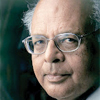We are pretty complacent these days about the balance of payments. Our foreign exchange reserves exceed $350 billion – enough to finance imports for a year if we stopped exporting. There are not many countries with such a good external affairs minister – sorry, central bank governor. That is not only my view; the world thinks so. It increased its investment in India by $60.3 billion, from $820.5 billion at the end of March, 2014 to $880.8 billion a year later. Of the inflows, $8.6 billion went into the stock market, $21.9 billion went into the bonds of our governments and companies, $22.0 billion was directly invested in our businesses, and another $11.3 billion – from nonresident Indians – went into currency and deposits. They brought in foreign exchange, of which the Reserve Bank added $37 billion to its reserves. Indians invested $34.1 billion abroad; the difference mostly ended up as investment abroad by the Reserve Bank, commonly known as foreign exchange reserves.
This is what the Reserve Bank’s press note of 30 June on the international investment position tells us. On the same day, it issued another press note on the international debt position. What is the difference? The first note includes debt securities which, as I said above, increased by $21.9 billion. The second one shows an increase in total debt by $29.5 billion, from $446.3 billion to $475.8 billion. There was an increase in commercial borrowings of $32.4 billion and in NRI deposits of $11.4 billion. There were offsetting falls of $7.0 billion in short-term debt, $2.7 billion in export credit and $3.0 billion in bilateral debt.
Thus, the Reserve Bank gives us two sets of assets and liabilities; the first one on foreign investment, and the second one on foreign debt. For one it gives only annual figures; for the other, it gives quarterly figures. Why two sets? I guess the difference is that the items in the first set of tables are marketable, and those in the second one are not. How clear is this difference? If an asset is never bought and sold, it is non-marketable; if there is an active market in the asset – for instance, in stocks and shares – it is marketable. But assets that are not marketed are not necessarily unmarketable. Some are; for instance, a bank will not normally sell the loans it has given to its clients. But business loans may be transferred from one company to another, or squared off. The distinction is not clear enough for the Reserve Bank to issue two sets of tables; and both are parts of the country’s total asset and liability position. Some liabilities, such as NRI deposits, figure in both sets of tables. So in my view, the Reserve Bank is only confusing the users of its statistics by issuing these figures separately; it should combine them.
There can be another reason for distinguishing between them: unmarketable liabilities have only one value, whereas marketable securities have a historical value at which they were first contracted, and a market value. But the Reserve Bank resolutely avoids market values; looking at its press note, one would not even know that they exist. This is primitive. For businessmen, the historical value is dead and gone; they will be interested only in the market value. The Reserve Bank should also start giving us market value figures.
Suppose, then, that we were to combine these two sets of figures; what would we get? That India’s net investment position worsened from $783 billion at the end of March 2014 to $838 billion at the end of March 2015: Indian businesses borrowed and sold equity worth $55 billion in the past financial year. The gross capital inflows were $90 billion, of which trade-related borrowings ($32 billion), portfolio investment ($32 billion) and direct investment ($22 billion) were the most important. The chief offsetting flow ($7 billion) was credit given by Indian exporters to their clients abroad.
There is nothing to worry about in the capital inflows. They can only increase the funds available to our business, and some of them might be accompanied by technology and management expertise. In fact, we should encourage such inflows, for example by removing the pernickety restrictions that Nirmala Sitharaman’s ministry administers on import and employment of foreigners.
What does worry me, however, is the substantial inflows of debt: our businesses are borrowing a lot of money, long- and short-term, from abroad. And the reason is obvious: interest rates are higher in India than abroad. Why are they high? Because the Reserve Bank keeps them high. And why does it push up the price of credit for business? Because its favourite daughters, the banks, like it that way: it enables them to give absurdly high salaries and perks to their employees. Rajan should dismantle this malign oligopoly.
(The column appears in the August 1-15, 2015 issue)

